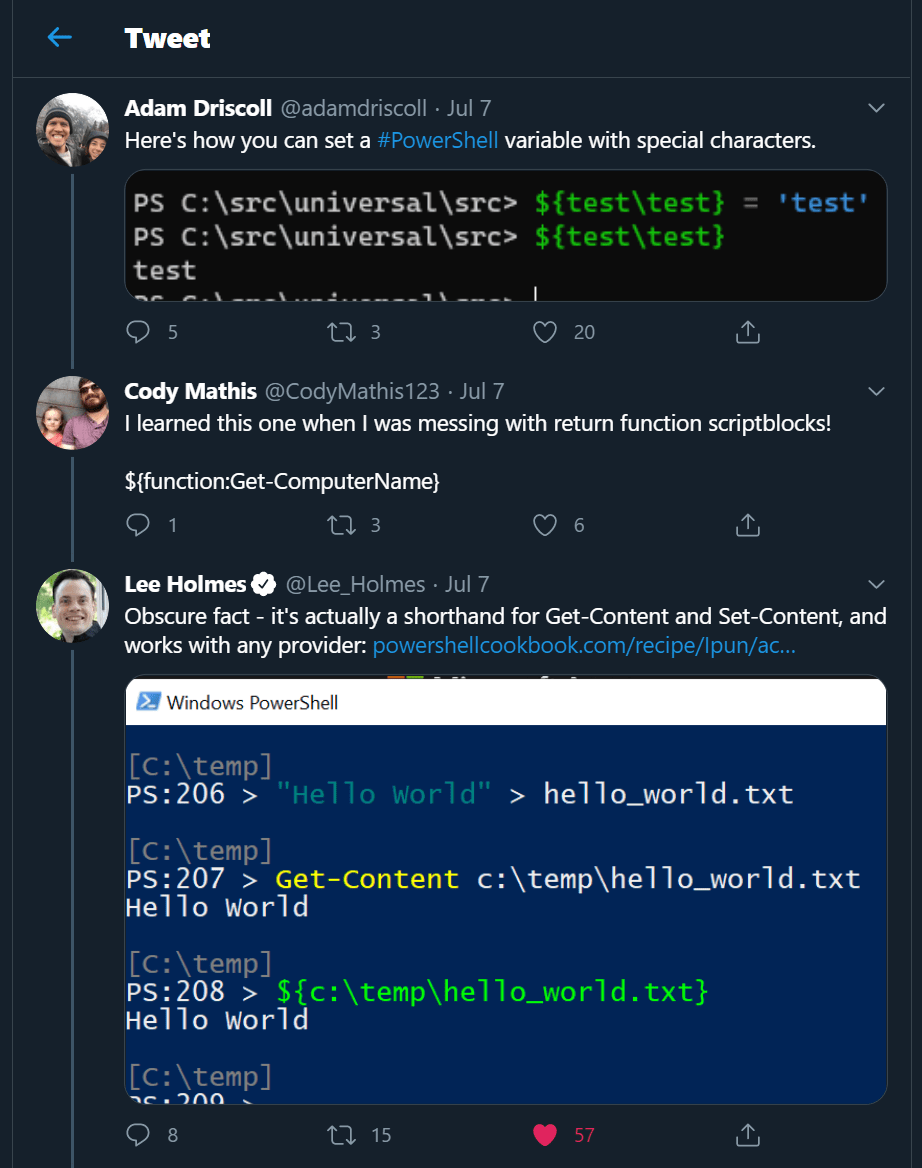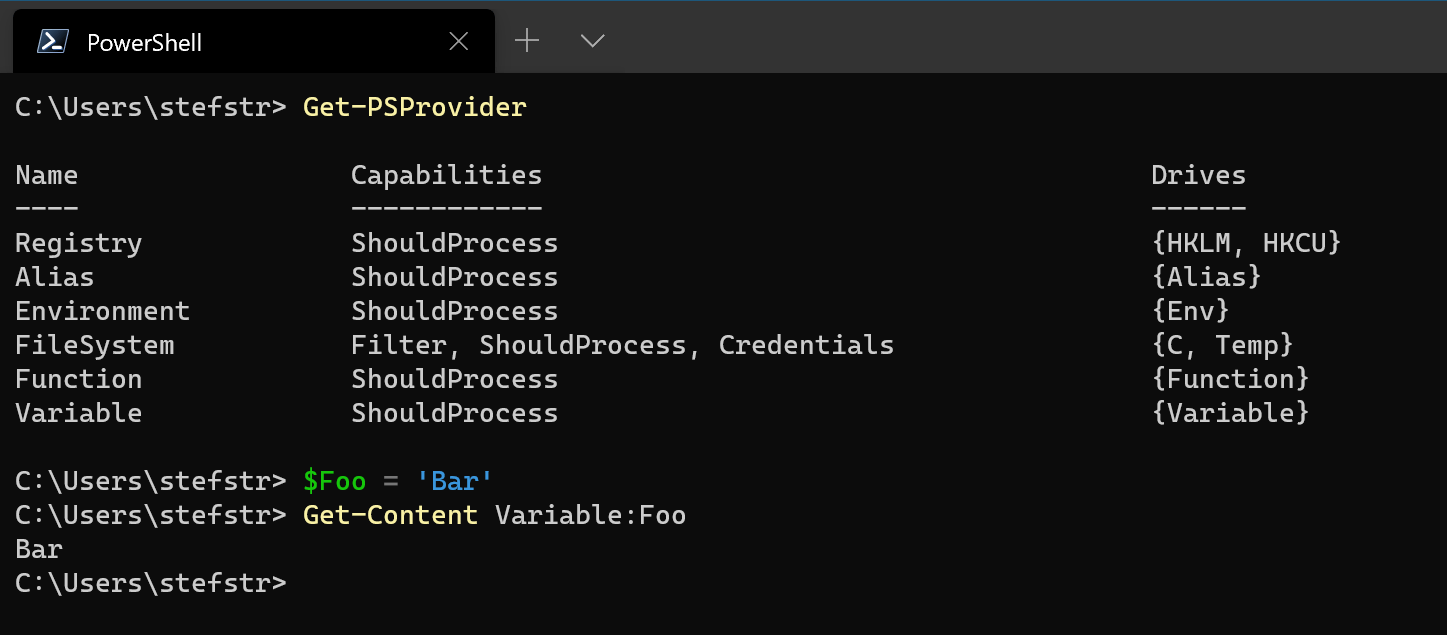PowerShell variables level 400
Contents
Introduction
While being a Microsoft Premier Field Engineer some years ago I regularly delivered different PowerShell workshops to customers and I always discussed PowerShell variables. So I thought I knew the ins and outs of PowerShell variables, but recently I saw something new about PowerShell variables which I was not aware of. It was in the blog post from James/Jim Truher about “Native Commands in PowerShell – A New Approach”
In that blog post he used the following example:
# retrieve data from REST endpoint
$baseUrl = "http://127.0.0.1:8001"
$urlPathBase = "api/v1/namespaces/default"
$urlResourceName = "pods"
$url = "${baseUrl}/${urlPathBase}/${urlResourceName}"
$data = (invoke-webrequest ${url}).Content | ConvertFrom-Json
And my interest was drawn to the part where the url variable was concatenated.
$url = "${baseUrl}/${urlPathBase}/${urlResourceName}"
And then I also saw these Tweets in my timeline.

Time to investigate PowerShell variables in more depth.
Get-Help About_Variables
So what did I teach during my PowerShell classes? Right, you start at the PowerShell help.
Get-Help About_Variables
A variable is a unit of memory in which values are stored. In Windows PowerShell, variables are represented by text strings that begin with a dollar sign ($), such as $a, $process, or $my_var.
Variable names are not case-sensitive. Variable names can include spaces and special characters, but these are difficult to use and should be avoided.
Ok I already knew that, but does the help file explains ${foo} = ‘bar’?
Yes there is information in the About_Variables help file. Told you so to start with the Get-Help cmdlet ;-)
VARIABLE NAMES THAT INCLUDE SPECIAL CHARACTERS
Variable names begin with a dollar sign. They can include alphanumeric characters and special characters. The length of the variable name is limited only by available memory.
Whenever possible, variable names should include only alphanumeric characters and the underscore character (_).Variable names that include spaces and other special characters, are difficult to use and should be avoided.
To create or display a variable name that includes spaces or special characters, enclose the variable name in braces. This directs PowerShell to interpret the characters in the variable name literally.
For example, the following command creates and then displays a variable named “save-items”.
C:\PS> ${save-items} = "a", "b", "c"
C:\PS> ${save-items}
a
b
c
The following command gets the child items in the directory that is represented by the “ProgramFiles(x86)” environment variable.
C:\PS> Get-childitem ${env:ProgramFiles(x86)}
To refer to a variable name that includes braces, enclose the variable name in braces, and use the backtick (escape) character to escape the braces. For example, to create a variable named “this{value}is” with a value of 1, type:
C:\PS> ${this`{value`}is} = 1
C:\PS> ${this`{value`}is}
1
So now I’ve learned that you can enclose the variable name in braces if you want to use special characters in your variable name.
But this does not apply for the example code James Truher used in his blog post.
# retrieve data from REST endpoint
$baseUrl = "http://127.0.0.1:8001"
$urlPathBase = "api/v1/namespaces/default"
$urlResourceName = "pods"
$url = "${baseUrl}/${urlPathBase}/${urlResourceName}"
$data = (invoke-webrequest ${url}).Content | ConvertFrom-Json
He creates ‘normal’ variable names without any special characters, like baseUrl, urlPathBase, urlResourceName and url, so why is he using
$url = "${baseUrl}/${urlPathBase}/${urlResourceName}"
to concatenate the ‘normal’ variable names into a new variable url?
Environment Provider
And there is where Lee Holmes helps in his Tweet response.
Obscure fact - it's actually a shorthand for Get-Content and Set-Content, and works with any provider: https://t.co/CydXeLDnjL pic.twitter.com/lyKuIVfnlD
— Lee Holmes (@Lee_Holmes) July 7, 2020
So Jim is here using Get-Content via the Variable Provider to the different variables. He is doing the following:
(Get-Content Variable:baseUrl) by using ${baseUrl}
Let’s try this too:
#Create a variable Foo with value Bar
$Foo = 'Bar'
#Retrieve variable using the Variable Provider
Get-Content Variable:Foo

I’ve learned something new about PowerShell variables, hope you also found this useful.
References
- Native Commands in PowerShell – A New Approach
- Access Environment Variables - Blog Post from Lee Holmes